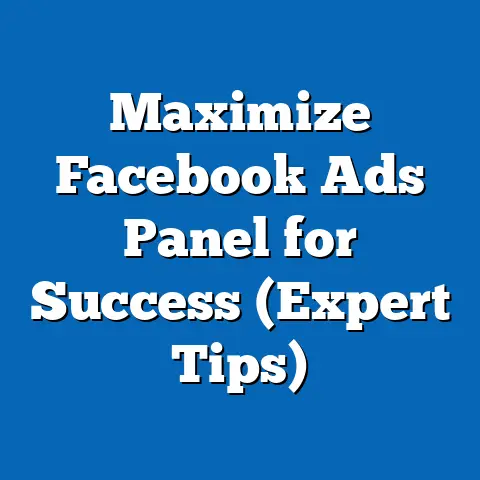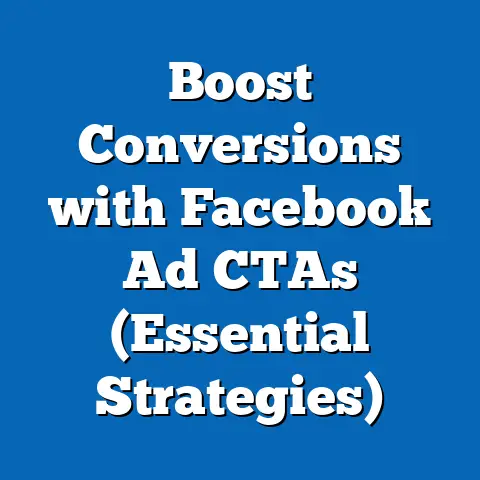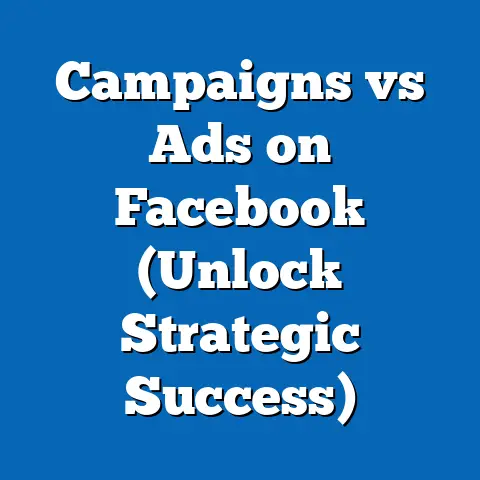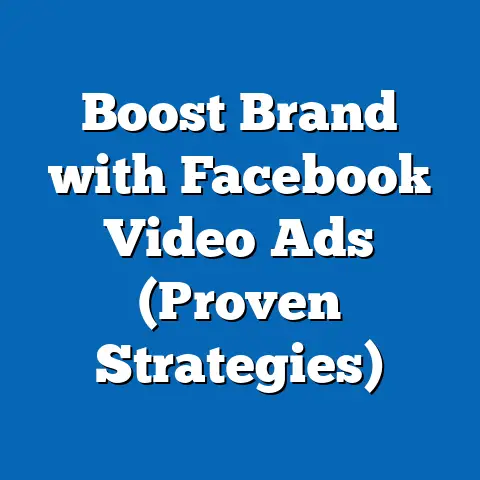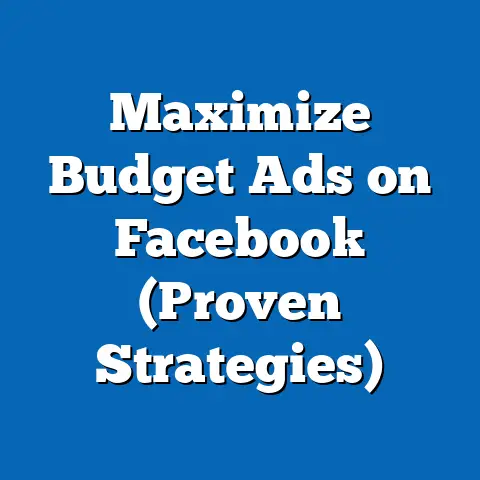Are Facebook Ads Truly Free? (Uncover the Hidden Costs)
In today’s digital age, it feels like everyone is vying for our attention online. I’ve seen firsthand how businesses, both big and small, are constantly searching for that magic bullet – a cost-effective way to reach their target audience and boost their bottom line. Facebook, with its billions of users, often presents itself as that golden opportunity. I remember when I first started exploring digital marketing, the promise of “free” advertising on Facebook was incredibly enticing. But as I delved deeper, I quickly realized that the reality is far more nuanced.
Facebook has become a colossal advertising platform, and the numbers don’t lie. Recent statistics show that over 9 million businesses actively advertise on Facebook, making it a critical channel for reaching potential customers. In fact, a significant portion of small to medium-sized businesses rely on Facebook for their marketing efforts. Why? Because the platform boasts unparalleled user engagement rates, allowing businesses to connect with their audience in ways that were previously unimaginable.
However, the allure of “free” advertising on Facebook is a double-edged sword. While setting up a Facebook page and posting content doesn’t cost a dime, the truth is that achieving meaningful results often requires a financial investment. In this article, I’ll peel back the layers and expose the hidden costs associated with Facebook Ads, giving you a realistic understanding of what it truly takes to succeed on this powerful platform.
The Illusion of Free Advertising
Let’s face it: we all love free stuff! And Facebook, in its early days, certainly gave the impression that it was a free-for-all marketing playground. You could create a business page, post engaging content, and watch your audience grow organically. I remember witnessing businesses building thriving communities simply by sharing valuable information and interacting with their followers.
But times have changed. While creating a Facebook page and posting content remains free, the reach of those posts has been dramatically curtailed. Facebook’s algorithm, designed to prioritize user experience, now heavily favors content from friends and family over content from businesses. This means that even if you have thousands of followers, only a small percentage of them will actually see your posts organically.
To illustrate this, consider a local bakery I worked with a few years ago. They initially relied solely on organic reach, posting mouthwatering photos of their pastries and announcing daily specials. While they saw some initial success, their organic reach steadily declined over time. Despite having a loyal following, their posts were simply getting lost in the noise. This bakery, like many other businesses, soon realized that organic reach alone was no longer sufficient to achieve their marketing goals.
The truth is, the “free” aspect of Facebook is more of a gateway drug. It gets you hooked on the platform, but to truly unlock its potential, you need to pay to play.
Takeaway: While creating a Facebook page and posting content is free, organic reach is severely limited, making it difficult to achieve meaningful results without investing in paid advertising.
The Real Cost of Facebook Ads
Now, let’s talk about the money. The real cost of Facebook Ads comes into play when you start running paid campaigns. Facebook offers a variety of ad formats, each with its own pricing structure and potential for success.
- Image Ads: These are the simplest and most common type of Facebook ad, featuring a single image and accompanying text. They’re relatively inexpensive and can be effective for driving traffic to your website or promoting a specific product.
- Video Ads: Video ads are more engaging than image ads and can be used to tell a story, showcase your brand, or demonstrate a product. However, they tend to be more expensive to produce and run.
- Carousel Ads: Carousel ads allow you to showcase multiple images or videos within a single ad unit. This format is ideal for highlighting different features of a product or telling a sequential story.
- Collection Ads: These ads are designed for e-commerce businesses and allow users to browse and purchase products directly from the ad.
The cost of Facebook Ads is determined by a bidding system. You set a budget and bid on the opportunity to have your ad shown to your target audience. The higher your bid, the more likely your ad is to be displayed. However, the actual cost you pay depends on a variety of factors, including:
- Competition: If there are many other businesses targeting the same audience, the cost of ads will increase.
- Targeting Options: More specific targeting options (e.g., targeting users based on their interests, demographics, and behaviors) tend to be more expensive.
- Ad Quality: Facebook rewards high-quality ads with lower costs and better placement. Factors like ad relevance, engagement rate, and landing page experience all contribute to ad quality.
To illustrate how ad spend can quickly escalate, let’s consider a hypothetical example. Imagine you’re a small clothing boutique targeting women aged 25-45 in a major metropolitan area. You set a daily budget of $50 and bid aggressively to reach your target audience. However, due to high competition, your cost per click (CPC) is $1.50. This means that you’re only getting around 33 clicks to your website each day. If your conversion rate is 1%, you’re only making one sale for every 100 clicks, which means you’re losing money on your ad spend.
In my experience, businesses should realistically expect to pay anywhere from $5 to $50 per 1,000 impressions (CPM) or $0.50 to $5 per click (CPC) for Facebook Ads. However, these numbers can vary significantly depending on the factors mentioned above.
Takeaway: The real cost of Facebook Ads involves paying to have your ads shown to a targeted audience through a bidding system. Costs are influenced by competition, targeting options, and ad quality, and can quickly escalate if not managed carefully.
Hidden Costs Beyond the Ad Spend
While the direct cost of Facebook Ads is a significant factor, it’s crucial to remember that there are other hidden costs that can impact your overall marketing budget. These costs often go unnoticed but can add up quickly.
- Creative Production Costs: Creating high-quality ad creatives (images, videos, and ad copy) requires time, effort, and often, professional expertise. Graphic design, video production, and copywriting services can be expensive, especially if you’re outsourcing them to freelancers or agencies.
- Time Investment: Running successful Facebook ad campaigns requires a significant time investment. You need to develop a strategy, create and test ads, monitor performance, and make adjustments as needed. This can be a full-time job, especially for businesses with complex campaigns.
- Additional Tools and Software: To effectively manage and optimize your Facebook Ads, you may need to invest in additional tools and software. Analytics platforms, A/B testing tools, and ad automation software can help you track performance, improve ad quality, and save time.
- Hiring Social Media Managers or Consultants: If you don’t have the time or expertise to manage your Facebook Ads in-house, you may need to hire a social media manager or consultant. These professionals can provide valuable guidance and support, but their services come at a cost.
I’ve seen businesses underestimate these hidden costs time and time again. They focus solely on the ad spend and fail to account for the other expenses involved in running successful campaigns. This can lead to budget overruns and disappointing results.
For example, I once worked with a startup that launched a Facebook ad campaign without considering the cost of creating high-quality ad creatives. They ended up using amateurish images and poorly written ad copy, which resulted in low engagement rates and a waste of ad spend. They eventually realized that they needed to invest in professional creative services to improve their campaign performance.
Takeaway: Hidden costs beyond the ad spend, such as creative production, time investment, additional tools, and hiring professionals, can significantly impact your overall marketing budget and should be carefully considered.
Measuring ROI and Conversions
Investing in Facebook Ads is only worthwhile if you’re seeing a return on your investment (ROI). Measuring ROI involves tracking conversions and analyzing the success of your campaigns. This can be a challenging task, as it requires accurately attributing sales and leads to your Facebook Ads versus other marketing channels.
Facebook Insights provides a wealth of data about your ad performance, including impressions, clicks, reach, engagement, and conversions. You can use this data to track key metrics like cost per conversion (CPC), return on ad spend (ROAS), and conversion rate.
However, accurately measuring ROI can be tricky. For example, a customer may see your Facebook ad but not click on it. They may later visit your website directly or purchase your product in-store. In this case, it’s difficult to attribute the sale directly to your Facebook ad.
To overcome this challenge, you can use tracking pixels and UTM parameters to track website traffic and conversions generated from your Facebook Ads. You can also use attribution modeling to assign credit to different touchpoints in the customer journey.
It’s important to remember that ROI is not just about immediate sales. Facebook Ads can also be used to build brand awareness, generate leads, and drive traffic to your website. These activities may not result in immediate sales, but they can contribute to long-term growth and profitability.
I’ve seen businesses make the mistake of focusing solely on short-term sales and neglecting the long-term benefits of Facebook advertising. This can lead to a narrow view of ROI and a missed opportunity to build a sustainable brand.
Takeaway: Measuring ROI is crucial for determining the success of your Facebook Ads. Accurately tracking conversions and analyzing campaign performance can be challenging, but essential for optimizing your ad spend and achieving your marketing goals.
Conclusion
So, are Facebook Ads truly free? The answer, as you now know, is a resounding no. While creating a Facebook page and posting content is free, achieving meaningful results requires a financial investment. The real cost of Facebook Ads involves paying to have your ads shown to a targeted audience through a bidding system. And beyond the direct ad spend, there are hidden costs associated with creative production, time investment, additional tools, and hiring professionals.
To succeed on Facebook, you need to approach advertising with a clear understanding of both the visible and hidden expenses. This means setting a realistic budget, creating high-quality ad creatives, targeting your audience effectively, and measuring your ROI carefully.
By understanding the true cost of Facebook Ads, you can make informed decisions about your marketing strategies and maximize your chances of success. Don’t be fooled by the illusion of free advertising. Embrace the reality, and you’ll be well on your way to unlocking the power of Facebook for your business.
Now I’d love to hear your thoughts and experiences. Have you run Facebook Ads before? What was your experience with the hidden costs? Share your stories in the comments below!

